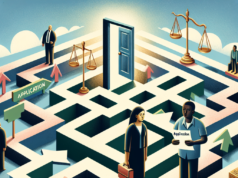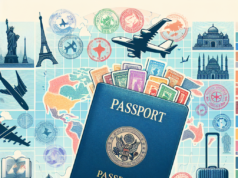
Immigration reform is a controversial and complex issue that has been at the forefront of political discourse for decades. The idea behind immigration reform is to improve the current immigration system and to address the needs and challenges of immigrants living in the United States. Immigration reform is a contentious issue because it encompasses a wide range of topics, such as border security, family reunification, legal status for undocumented immigrants, and employment opportunities for foreign workers. The goal of this article is to provide an overview of the concept and history of immigration reform, as well as examine some of the current proposals and their potential impact.
What is Immigration Reform?
Immigration reform refers to changes to the laws, policies, and practices that govern how people enter and leave a country, as well as their rights and responsibilities once they are in the country. The United States has a complex system for admitting immigrants, which is governed by several federal agencies, including the Department of Homeland Security, the Department of State, and the Department of Justice. Immigrants can come to the United States for a range of reasons, including family reunification, employment opportunities, humanitarian protection, and education.
There are many different opinions about what immigration reform should entail. Some people advocate for more stringent border controls to prevent unauthorized immigrants from entering, while others argue for a pathway to citizenship for undocumented immigrants who are already living in the United States. Some proposals aim to prioritize the rights of American workers by limiting the number of foreign workers who can be admitted each year, while others argue that a larger foreign workforce is necessary to meet the needs of the U.S. economy.
The History of Immigration Reform in the United States
Immigration has been a contentious issue in the United States for centuries. The first immigration laws were passed in the late 1800s and were designed to restrict the entry of Chinese laborers, who were seen as a threat to American workers. In the early 1900s, Congress passed a series of laws that created quotas for immigrants from different parts of the world, based on their nationality and race. These laws were designed to limit the number of immigrants who could enter the United States and to favor immigrants from Western and Northern Europe.
In the 1960s, Congress passed the Immigration and Nationality Act, which eliminated many of the quotas that had favored European immigrants and created a more flexible system for admitting immigrants based on their skills, education, and family relationships. This law also established a framework for refugees and other individuals fleeing persecution to enter the United States.
Since then, there have been numerous attempts to reform the immigration system. In the 1980s, Congress passed a law that gave legal status to millions of undocumented immigrants and imposed penalties on employers who hired unauthorized workers. In the 2000s, Congress attempted to pass comprehensive immigration reform legislation that would have created a pathway to citizenship for millions of undocumented immigrants, but these efforts were ultimately unsuccessful.
Current Proposals for Immigration Reform
The current administration has proposed several changes to the immigration system, including changes to the legal status of Dreamers, individuals who were brought to the United States illegally as children. The administration has also proposed changes to the H-1B visa program, which allows U.S. employers to hire foreign skilled workers. These changes would restrict the number of H-1B visas available and require employers to pay higher wages to foreign workers.
Another proposal put forth by some lawmakers is a pathway to citizenship for millions of undocumented immigrants. This proposal would require these individuals to go through a background check and pay a penalty, in addition to meeting other requirements.
Other proposals aim to improve border security by building a wall along the U.S.-Mexico border, increasing funding for technology and personnel at ports of entry, and implementing stricter penalties for individuals who cross the border illegally. Some lawmakers are also pushing for reforms to the legal immigration system, such as changes to the family reunification program and the creation of a guest worker program.
Potential Impacts of Immigration Reform
The proposed changes to the immigration system would have far-reaching impacts on individuals, families, and the U.S. economy. For Dreamers, changes to their legal status would provide much-needed security and stability, allowing them to work, travel, and contribute to their communities without fear of deportation. For foreign workers, changes to the H-1B visa program could limit career opportunities and make it more difficult for employers to find skilled workers. This could have ripple effects on U.S. industries such as technology, healthcare, and education.
In terms of border security, increased funding and stricter penalties could deter individuals from attempting to cross the border illegally. However, the construction of a wall along the U.S.-Mexico border has been controversial and could have negative environmental, economic, and humanitarian impacts.
Reforms to the legal immigration system, such as changes to the family reunification program and the creation of a guest worker program, could have positive impacts on families and U.S. businesses. The family reunification program allows U.S. citizens and permanent residents to sponsor their relatives for legal status, while the guest worker program would allow employers to hire foreign workers for temporary or seasonal employment.
Conclusion
Immigration reform is a complex issue that touches on a range of topics, from border security to employment opportunities for foreign workers. The proposals put forth by lawmakers and the current administration have the potential to impact millions of individuals and families, as well as the U.S. economy as a whole. It is important for policymakers to consider these impacts and to work towards solutions that prioritize the needs of all Americans, regardless of their immigration status.
Immigration laws have been changed recently to be more strict on immigration policies. However, in some cases, immigration reform also includes a decrease in restrictions on immigration, especially in cases where individuals are seeking asylum.
In general, immigration reform is aimed at preventing illegal immigration into the United States. Immigration is legal in cases where individuals have acquired the proper visa by filing the necessary paperwork. However, there is a limit of allowable visas, sometimes increasing the competition for those visas. This can translate to illegal immigration by those that cannot obtain a visa. In addition, immigration may include a misrepresentation of facts in order to acquire a visa or immigrants that stay in the country once their visa has expired.
Immigration reform simply seeks to streamline the immigration process, making it easier to track immigrants and the number of visas granted on a yearly basis.



























